Value First: The Key to Sustainable Product Growth
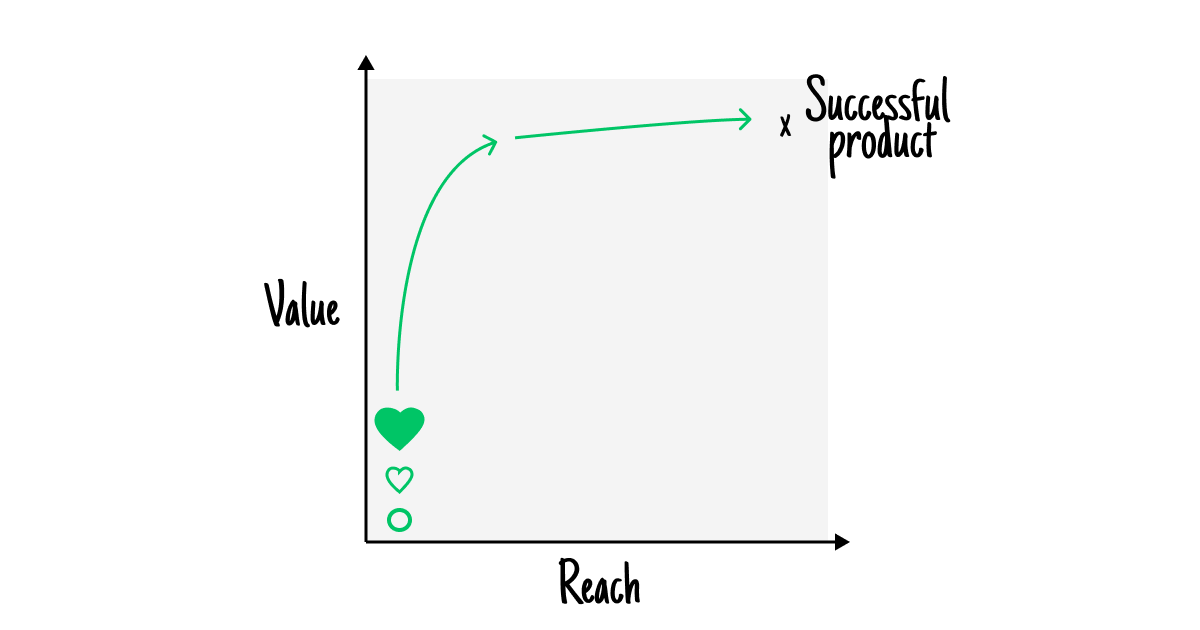
Introduction
Every successful product delivers fantastic value and reaches millions of people.
Yes, it is simple.
No, it’s not as easy as it sounds. Why?
It requires focusing on the right aspects of your product and distribution, delivering to the right people, and resisting external influences as long as possible.
In this article, I’m sharing what I learned about growing products over the past 10 years. Here are the main topics I will cover:
- The limitation of our current product launch strategy.
- The counter-intuitive way to launch digital products.
- The step-by-step process to grow digital products.
Let’s start with a simple illustration of product growth.
The growth grid
After numerous discussions about Growth, Digital distribution, and GTM strategy, it all comes back to two topics: the value your product delivers and the people you can reach. If you can master both, you will have a successful product.
Let’s visualize this in a simple grid. Reach on X and Value on Y.
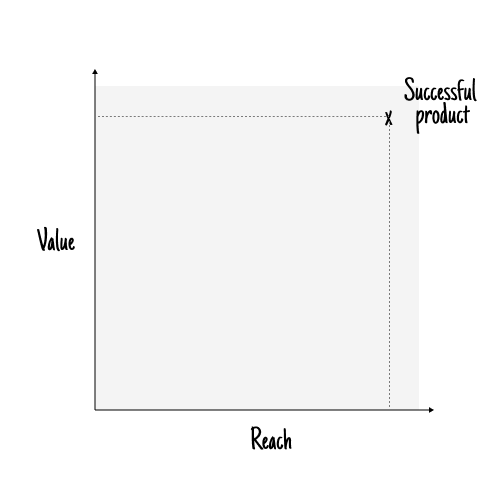
What do I mean by Reach?
The reach represents the available opportunity for your product. In other words, it is the Total Addressable Market (TAM).
Before the internet, the Reach was geographical, limited to the region where the product was available.
Today, you can reach people worldwide, 24/7 and on different platforms, from your sofa.
By doing ads on Google and Facebook only, you can reach 5 billion people.
What do I mean by Value?
Value is the perceived worth of your product. It answers the question your customers ask themselves (consciously or not): Is this worth it?
“Well, my product is free, so of course, it’s worth it,” you might think.
Money isn’t the only currency of value. Attention and time are also essential to consider.
Your users may ask themselves: “Is it worth going through the challenging signup process? Is it worth it to spend 2 minutes setting up my profile? Is it worth it to get sales calls?
—
Now that we’ve established the context let’s start.
Where do we all start
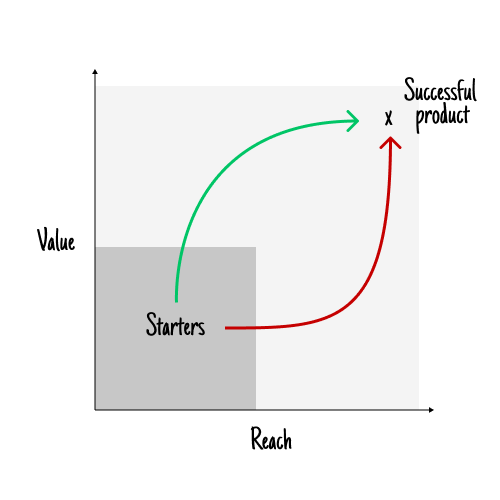
Launching a product doesn’t mean it’s done. It means that the product can face real customers (as opposed to test users).
If you want to grow your product, your goal is to develop the two dimensions. The question is: On which dimension should you focus first?
Let's have a look to the first one.
The rat race
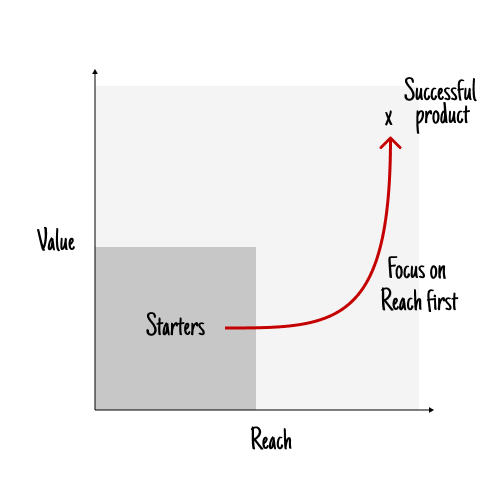
The most common journey. You’ve been working behind the scenes; now it’s time to share it worldwide.
You have an advantage: you have access to resources (money, distribution channel, employees, family…, etc.). Those resources come with a downside: You need to show results fast.
Because you have a biased opinion about your product (you believe it’s pretty great!), you think marketing is about showing your product and then, people will buy it.
Buying reach
The fastest way to get your product in front of people is to buy the reach.
As mentioned above, it is easier than ever to reach people. You can set an ad through platforms like Meta or Google and reach billions. The only downside is that you must pay for the service, which quickly becomes expensive.
Now that half the globe has seen your product, what’s next?
Showing your ads to millions of people won’t make them buy your product. Reach doesn’t mean your product is superior or provides value to people; it simply means that your is being shown to more people.
If you were online yesterday, you saw between 347 and 420 ads. How many of them can you name/remember? How far from none?
With the right marketing triggers, you can find short-term solutions by playing on novelties or the Fear of missing out. However, those tactics will fade with time, resulting in an increase in your CAC (customer acquisition cost) and a decrease in your margin.
This is why it’s called the rat race: the longer you do it, the harder it becomes.
The greater the reach, the harder it is to generate value
Imagine you own a restaurant and your job is to delight your customers with the perfect dish. On the first day, you only have one customer. You create the right dish for your customers and meet their expectations. Bravo!
The next day, 15 different people come to your restaurant. They don’t know each other, and each has a favorite dish. Do you expect them all to have the same favorite dish?
And what do you serve? Fifteen different dishes or 1 average dish?
The same applies to digital products; the more different people you reach, the harder it becomes to serve great value to all of them.
Malcolm Gladwell illustrates the challenge in his TED talk about spaghetti sauce.
“There is no perfect pickle; there are only perfect pickles.” Doctor Moskowitz
Conclusion of the rat race
Focusing on reach first is dangerous and tends to be a trap. The pursuit of reach will make your product boring. More reach means average; you must offend no one and try to satisfy everyone. It will lead to compromises, generalizations, and, most importantly, a painful path to growth.
The truth is, it won’t get better. The longer you do it, the harder it will become.
What happens if you are in the rat race? Fortunately, it’s not too late to pivot and focus on the value-first approach. The same process will apply.
Focusing on value first
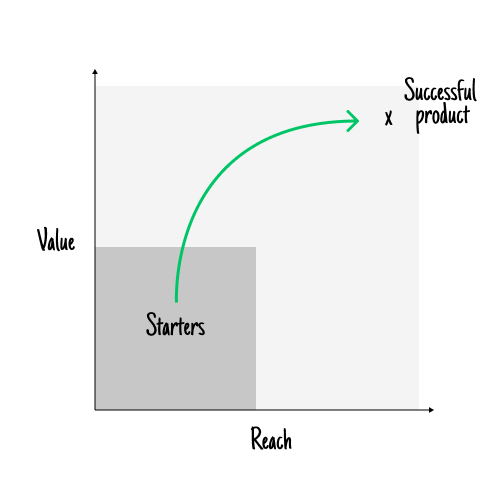
A less common journey, likely because of how difficult it is before seeing any return on investment.
The best example of a value-focused product I know of is Superhuman, a mail service like Gmail. The major difference is that it costs $30 monthly to use the service.
Why do people pay $30 when they can get Gmail for free? Because it’s worth it, for them.
In this article, Superhuman founder Rahul Vohra details how his company focuses on value first.
In addition to this article, I added my personal process for focusing on value. Some of the steps may sound counterintuitive, so I share concrete examples from Superhuman for each step.
Let’s start with the first step:
1) Focus on the smallest viable audience
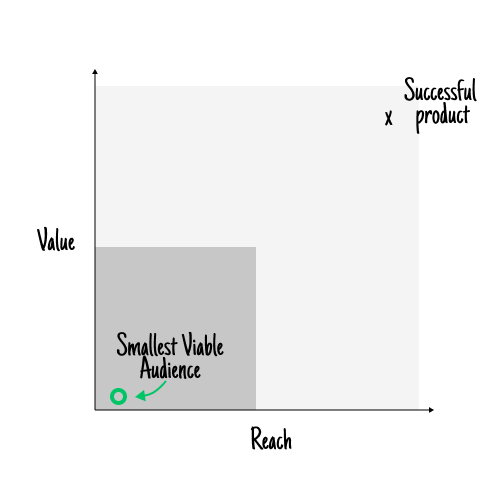
What is the opposite of max reach? It’s focusing on the smallest viable audience, a term coined by Seth Godin and shared in his book This is marketing.
Finding your smallest viable audience is hard because you have to be specific. You cannot hide behind “our product is for everyone.” You cannot wait for your users to find you because they won’t.
You have to take action and start focusing on the people you want to serve— the ones who see the benefits of your product and are willing to forgive you for the small bugs.
“A lot of people have trouble with that. They say: why should I do all this work if I don’t want to reach everyone? That means you have denied the people you’re serving their humanity. Seth Godin
Find the fraction of your audience that can’t wait for your solution—people who value the most what your product can deliver.
How small are we talking about?
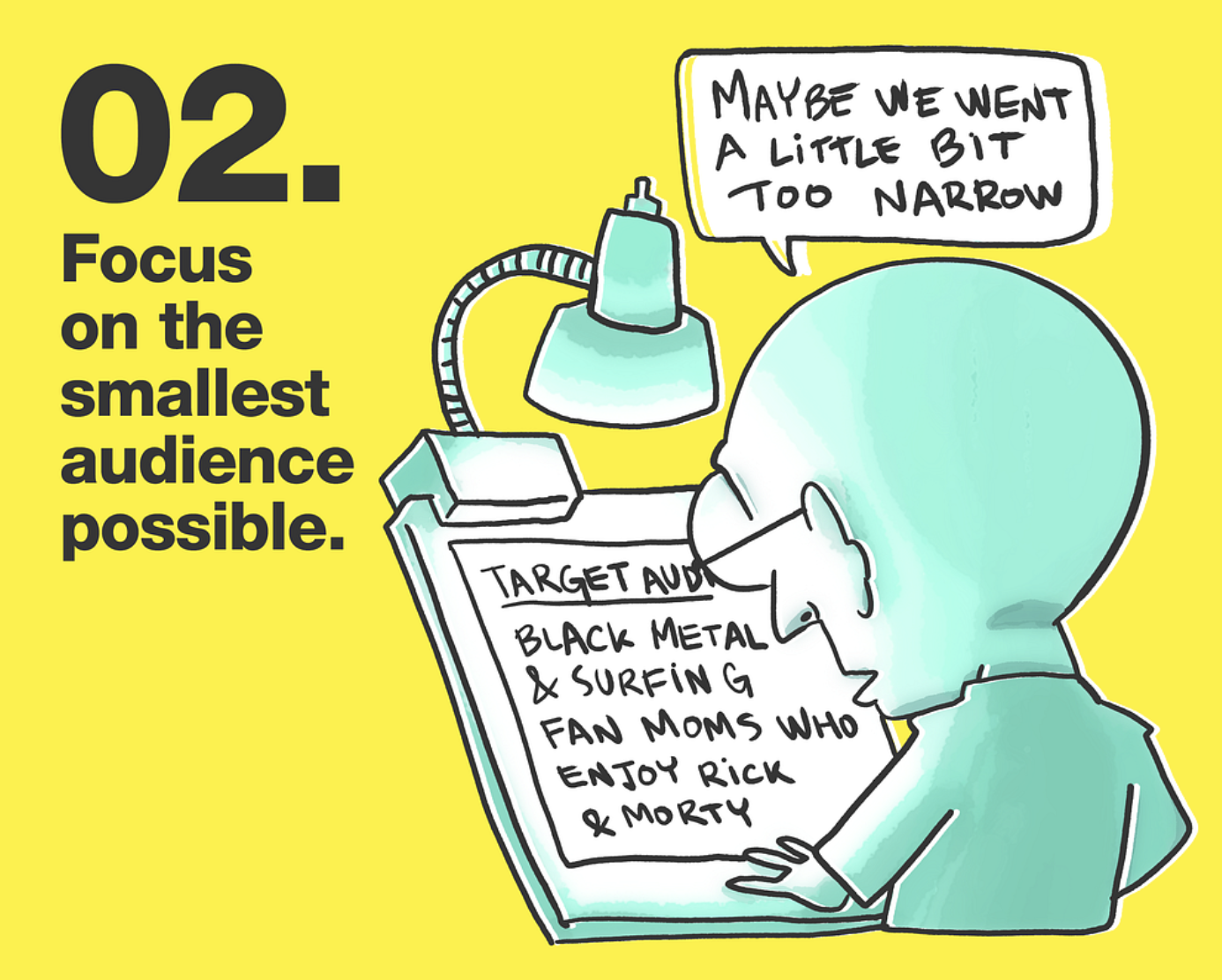
The smallest is the one that forces the uncomfortable focus on the users. And nothing else.
20? 200? 2000? It depends and it doesn’t matter.
By focusing on this small audience, I have an edge over the generalist [Products] out there. I can address their biggest, most specific pains. This is what remarkable marketing is all about. Louis Grenier.
Here is another example of audience focus impact. Superhuman decided to “focus on founders, managers, executives and business development — temporarily ignoring all other personas” while conducting user research. As a result, they increased by 10% their Product Market Fit score.
Focusing on the smallest viable audience is the first step, and a mandatory one. Without understanding specifically who you serve, you won’t be able to address what your audience value the most.
2) Find out what your audience values the most
What do the users value? What do they want?
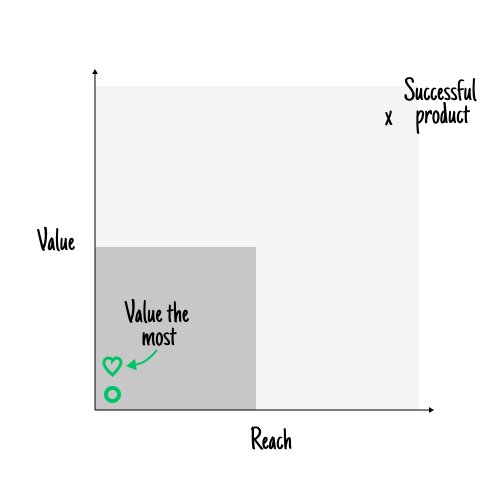
I find myself asking those questions too many. And for a long time, I struggled to put words on the different elements of value of my audience.
Then, I found the30 Elements of Value, the most viewed article from Harvard Business Review.
In the article, the authors named, illustrated and leveled the different elements of value.
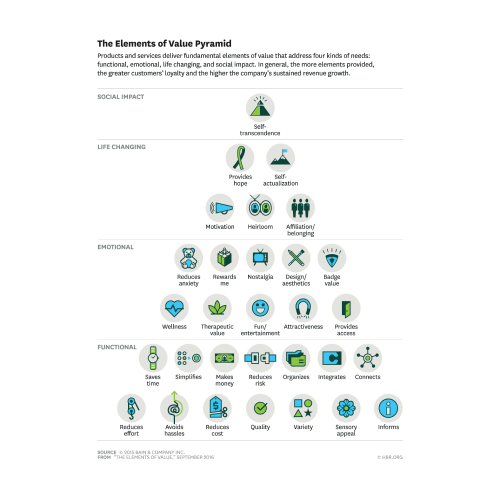
The pyramid is a great starting point for identifying the value you want to focus on.
As a starter, you don’t need to aim for one element of each level of the pyramid. If you are fortunate, you will reach that after years of user-centricity.
You need to identify the 1 or 2 elements your audience values the most and ensure you deliver on them. There is no shame in starting at the bottom; we all need to start somewhere.
Superhuman asked their audience and understood they were looking for more speed and automation (save time and reduce hassle, if we translate this into the pyramid of value). Focusing on delivering on those two values made a difference for the whole product and company.
Once you focus on users and value, the next step is understanding how far you should go?
3) Go the extra mile and tell them
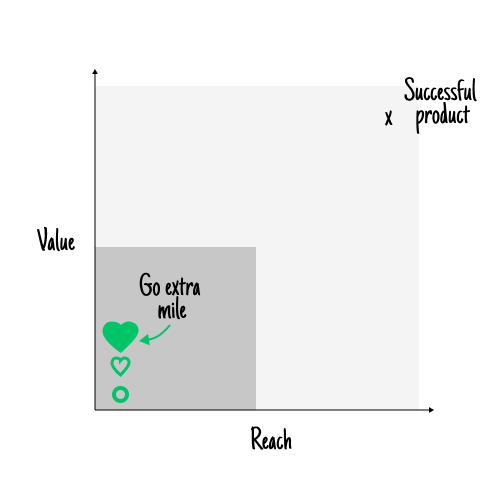
If you want to stand out and be worth taking a risk on, you need to exceed expectations and deliver exceptional value.
What does it mean?
This means that if your product delivers a 10KB quality optimization, most people won’t experience the pain of changing their habits. In other words, your product might be better, but it is not worth the change for your users.
Your product doesn’t have to be the best. Focusing on delivering 1–2 exceptional elements of value for your Smallest Viable Audience is enough.
Building a better product isn’t enough; you need to communicate it. Communicating value and tailoring the right messaging is an integral part of the plan. If you product is 5 times faster but you don’t make it clear to your audience, they will never give it a try in the first place. You need to find the right balance between setting the expectations (Marketing) and delivering on your promise (Product).
Superhuman doesn’t save you 3 minutes per month on your email. They save you 4 hours a week and build the fastest email experience worldwide.
4) Get user feedback and iterate fast.
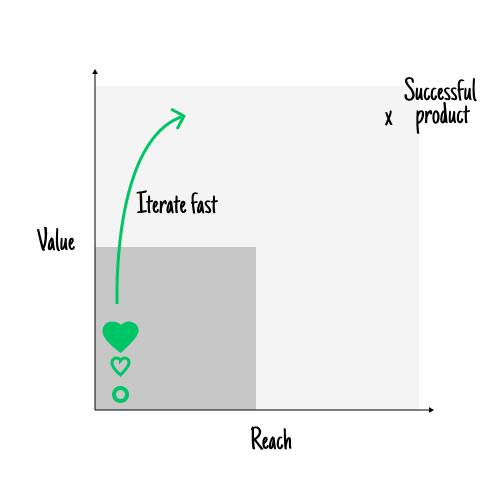
Now that we’ve covered the basics, we can start discussing what growing a digital product is all about: Collecting feedback from users and iterating fast.
Depending on the stage of your product development, different ways of collecting user feedback apply. For now, what matters is acknowledging that user feedback fuels your growth. Without it, you are just another fancy car parked on the side of the road.
Collecting Feedback
User feedback is the primary way to understand your progress in delivering value. It helps you understand what your audience wants and if you are delivering on it.
To get consistent and continuous insights from your users, you need to build a feedback engine: A simple system that helps collect, track, and understand your customer feedback regularly.
The feedback engine doesn’t have to be fancy. You can start today. Superhuman started with 200 users, a simple form and 4 questions.
Once you understand how users perceive your product, you can define specific ways to optimize its distribution.
Iterating fast
Having knowledge about your users and understanding their actions is great, but it’s meaningless without action.
With these insights, it’s time to roll up your sleeves and build your next features or communication plan.
Fortunately, you know what to build and for whom.
And it’s time to share the secret sauce. Successful product launches have nothing to do with great ideas and marketing experts. Success depends on your focus and capacity to iterate faster and longer than others.
It also applies to building a successful digital product
5) Survive the longest possible:
Let’s address the elephant in the room.
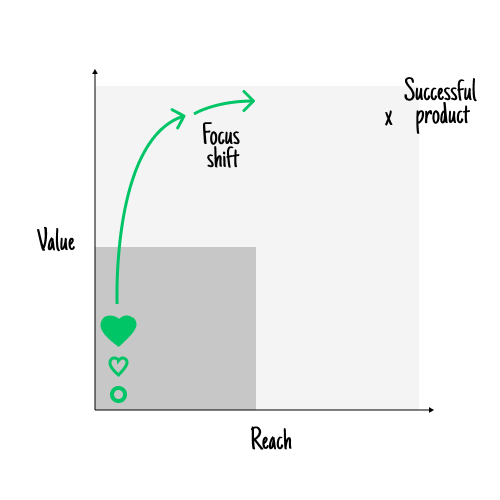
Focusing on delivering value is great, but value doesn’t equal revenue. Your partners, investors, and managers expect growth, not user surveys.
When is the right moment to switch focus from Value to Reach?
Based on my experience, there are two moments:
A) When you cannot afford to focus on value anymore
When the pressure for results is externally driven: You need to raise another round; you have a management presentation, and a new competitor is launching soon.
At some point, we all depend on outside forces. The less, the better, but I would be lying if I said you must ignore them.
You did your best, and now is the time to translate all the learning you have gathered and switch your focus to reach.
B) When you reach the value goal you set up
This is the ideal scenario. When you are confident your product is ready for the audience, you can distribute it at scale.
In the Superhuman case, the KPI they set up to understand value was the Product Market Fit (PMF) score. They believed that reaching 40% would mean their product delivered outstanding value for their targeted audience. During the product development, they reached 58%, giving them the confidence to release Superhuman as a successful digital product.
It’s important to define a “Value” goal on a strategic level. I already covered in detail how I set Goal, KPIs and metrics for digital products.
Conclusion
Launching a successful digital product is a simple five-step process, but that doesn’t mean it will be easy.
Narrowing the focus on your smallest viable audience will help you stand out and become the obvious solution for them.
Strive to deliver exceptional value and stand out by delivering and communicating quality.
Maintain a fast pace to deliver incredible value as long as possible before running out of resources. We all do at some point.
This article clarifies your growth expectations and where you should focus your efforts. As we mentioned at the beginning, some steps of the process are counterintuitive. I hope this article clarifies those steps and answers your questions.
A last quote from Superhuman founder:
“Investors advising early-stage teams should avoid pushing for growth ahead of product/market fit. As an industry, we all know that this ends in disaster, yet the pressure for premature growth is still all too common. Startups need time and space to find their fit and launch the right way”. Rahul Vohra
